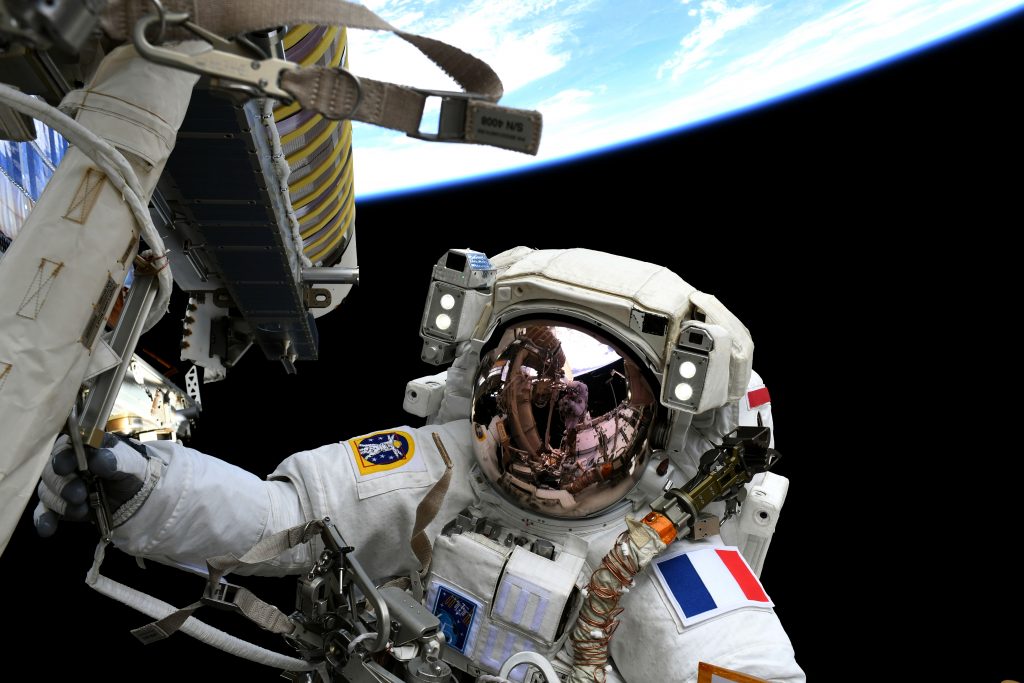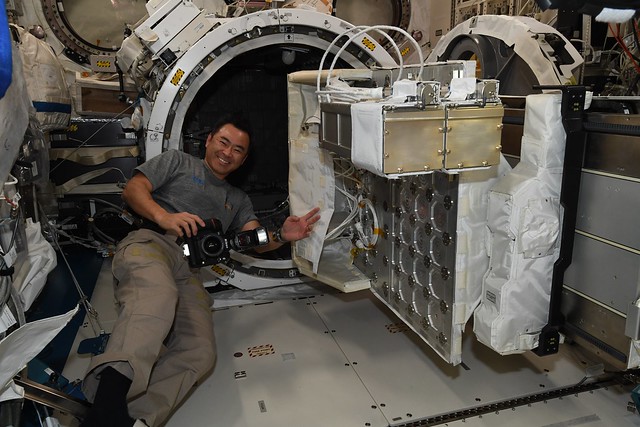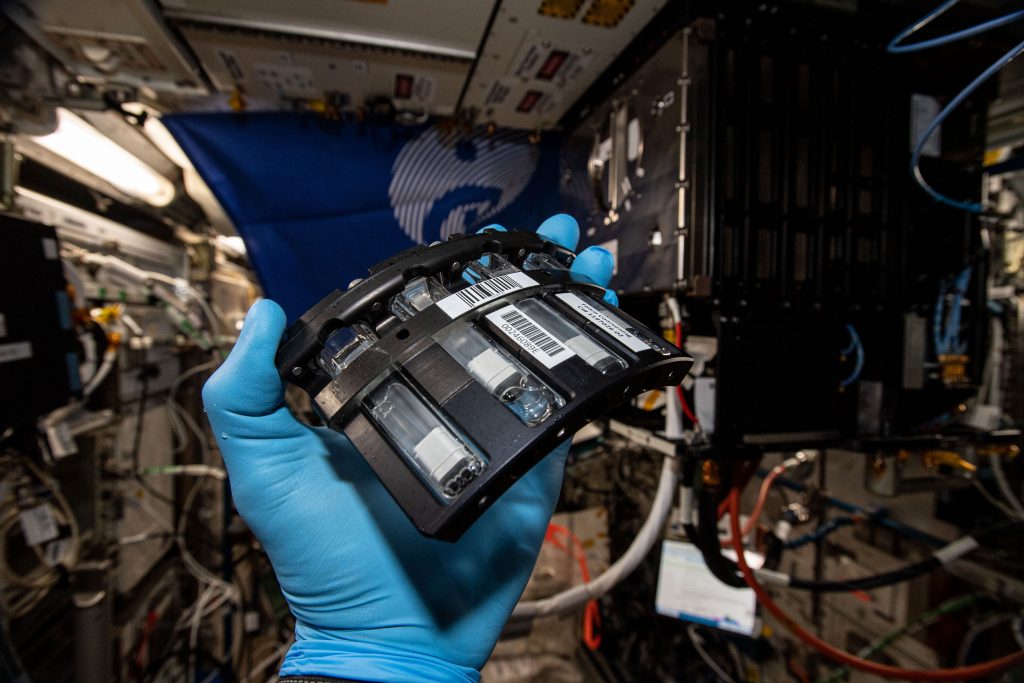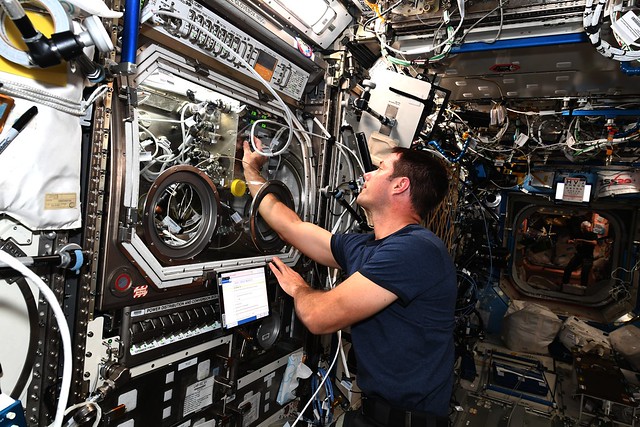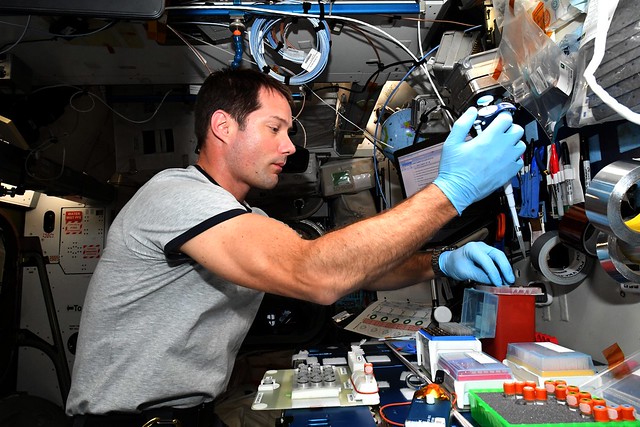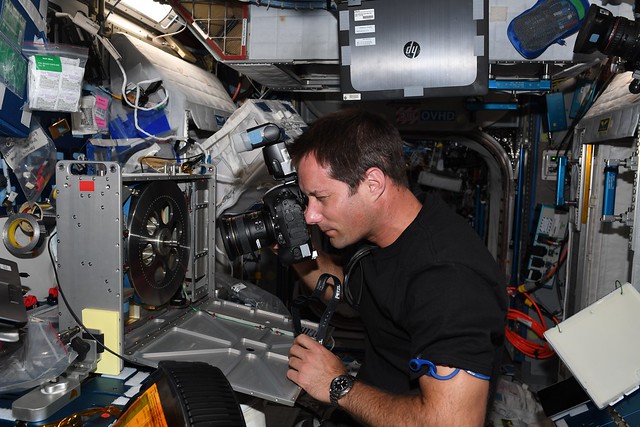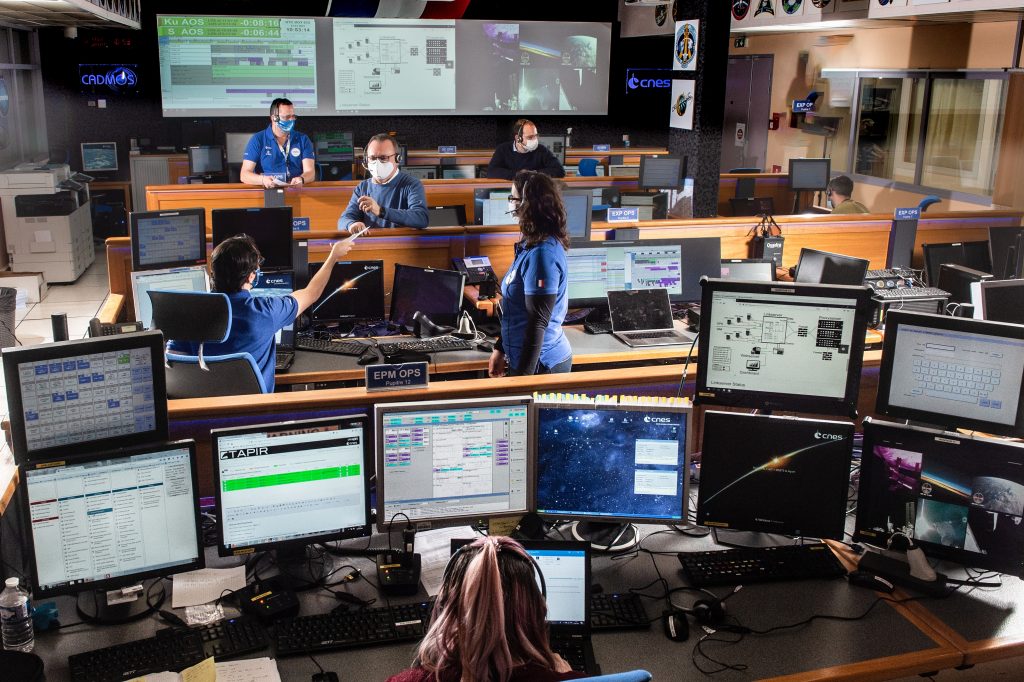Science
The new spacecraft arrivals and spacewalks take up a lot of an astronaut’s time and are more visual, but Thomas fit in much science in his 100 days on Mission Alpha. The list below is organised by theme, but not even exhaustive, some of the smaller experiments are not mentioned.
Biology and biotechnology
The Grip and Grasp experiments
The Grip and Grasp experiments
Thomas’ first large-scale European experiment in space was a familiar one: he set up the Grip and Grasp equipment during his Proxima mission in 2017. Four years on he is running the experiments himself by wearing a virtual reality headset and grasping objects while motion trackers record his arm movement and speed.
Grip and Grasp are two neuroscience experiments looking into how our brain takes microgravity into account when grabbing or manipulating an object.
Results could shed light on how to treat patients showing a loss of vestibular function on Earth, and contribute to the design of touch-based interfaces in future deep space exploration. This research could also identify potential hazards for astronauts when they move between environments with different levels of gravity, such as landing on Mars.
Muscle tone with Myotones
Astronauts experience muscle weakening in space and when they return to living with the effects of Earth’s gravity after a mission. The Myotones experiment monitors the muscle tone, stiffness and elasticity of the astronauts’ muscles with a non-invasive, portable device on the Space Station.
Thomas completed the first two science sessions together with NASA astronaut Megan MacArthur. A total of 12 astronauts will be taking part in it in the hope of identifying the best countermeasures and improving the lives of many people affected by strained muscles. The device is already used on Earth as an alternative to muscle biopsies.
Plant water management
Thomas worked on NASA’s Plant Water Management system to grow plants in space, and was part of NASA’s Advanced Plant Experiment-07 (APEX-07) examining how changes in gravity and other environmental factors associated with spaceflight affect plants at the level of gene expression.
Worms in space
The Molecular Muscle-2 experiment is trying to understand why astronauts lose some of their muscle mass in space.
During spaceflight an astronaut’s body changes. Losing muscle mass can affect their ability to work on a long space mission. Astronauts can lose up to 40% of their muscle after 6 months in space.
The very small worms, which can only be clearly seen under a microscope are C. elegans. It seems incredible but in many ways the tiny worms are similar to humans and share some of the essential biological characteristics. The worms help show the effect of changes in space, including alterations to muscle and the ability to use energy.
Understanding the causes of muscle loss in space may help astronauts in the future and address health problems on earth. Muscle loss caused by ageing might be better understood and the research could improve treatments for conditions such as diabetes.
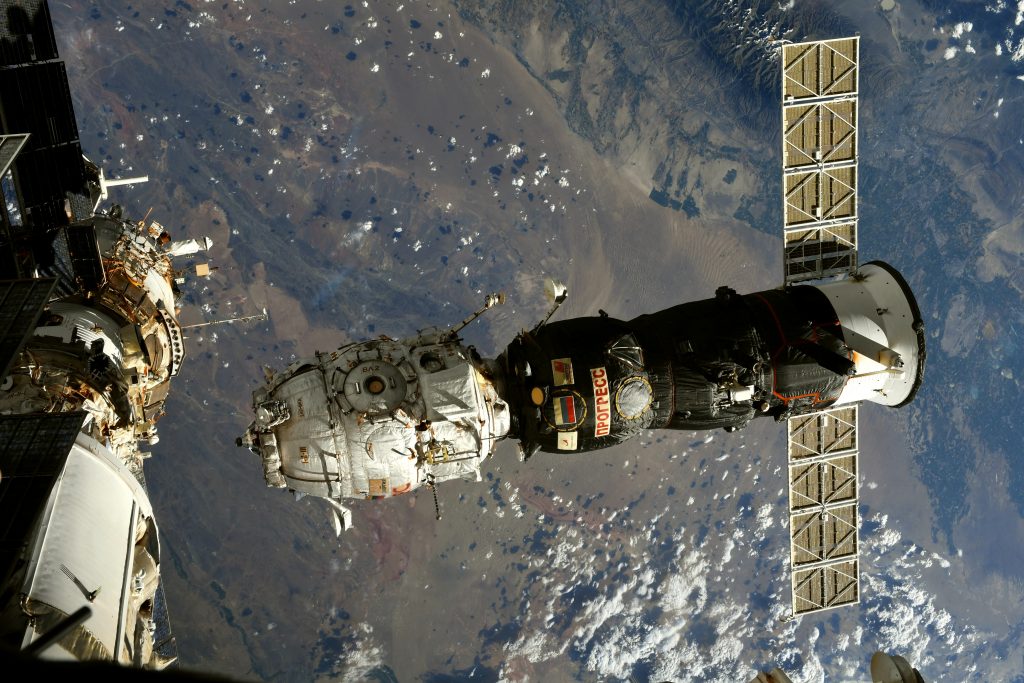
The Pirs docking compartment left the Space Station after 20 years of service and burned up safely in the atmosphere above the Pacific Ocean. Credits: ESA/NASA–T. Pesquet
Routine comes down to science – repetition is part of any research, and space is no exception. More than halfway through the mission, Thomas has supported numerous European and international experiments in microgravity.
Since Thomas is quite busy, we asked the scientists supporting the mission on the ground to help us pick up a few experiments from the over 200 investigations that are on his schedule, with 40 European ones. This is what they chose.
Oral Biofilms
This human research study observes how bacteria is affected by microgravity and investigates ways to counteract any potential harmful changes.
Technology development and demonstration
Pilote
Thomas and Megan are running sessions of the Pilote experiment in the European Columbus laboratory proposed by France’s space agency CNES. They have to virtually guide a drone through an obstacle course and grapple a spacecraft with a robotic arm.
The Pilote experiment evaluates a new way of providing tactile and visual feedback to astronauts when operating robots. A virtual reality headset and a haptic joystick recreate the feeling of pressure and touch when the astronauts fly a robotic arm.
The results from Pilote will help improve the astronauts’ robotic skills not only on the Space Station, but also for operating rovers on the surface of the Moon and Mars.
Ultrasonic tweezers
Thomas conducted an experiment last week looking at manipulating objects using acoustics. The Ultrasonic Tweezers experiment aims to test the principle of moving objects without any physical interaction.
An acoustic tweezer uses ultrasound to trap objects. By moving the sound beam it is possible to move an object with great precision. Thomas evaluated how the technique can be used in microgravity to capture small plastic or glass marbles and move them over an obstacle course.
Stable space bubbles with Foam Coarsening
Observing foams on Earth is tricky because the mixture of gas and liquid quickly starts to chang
Nanosats
Thomas worked together with Aki and Mark to prepare the launch of miniature cubesats from the Japanese Kibo module. Two satellites were launched, one led by the Univeristy of Manchester, and the other by Robertsville Middle School, the first will test aerodynamics in low Earth orbit, and the former monitor forest fires.
Everywear
Started during Thomas’ first mission Proxima, the Everywear app is an all-in-one solution for astronauts in space. Using their tablets and connected devices the app can store a wealth of information and present it to the astronaut. Thomas used the French demonstration to record his calorie intake.
3d Printer
The Space Station has a 3D printer to make parts as necessary. Thomas used it to print a part for the new toilet!
Lightweight Crew Communications Headset Deployement
Thomas setup a new radio communication device that as the name implies should be lighter and easier to work with.
Immersive Exercise
Astronauts exercise two hours a day to compensate for the loss of bone and muscle mass from living in weightlessness. The daily workout can quickly become repetitive in the closed and unchanging environment, leading to lack of motivation. The Immersive Exercise experiment aims to break the monotony with virtual reality. Coupled with the Space Station’s exercise bike, an astronaut can pedal in space while riding through Earth landscapes. Videos filmed in 360° on Earth are played back on the headset, with the speed changing depending on how fast the astronaut pedals. A number of scenes have been captured, including one trip around Paris and its monuments at Thomas’s request. Already in use in some terrestrial fitness centres, the Immersive Exercise equipment could evolve to include gradient difficulties to recreate mountain roads. The Immersive Exercise technology should keep astronauts motivated on the International Space Station and improve their performance – an important aspect to consider on longer missions to the Moon and Mars.
Physical science
Stable space bubbles with Foam Coarsening
Gravity pulls the liquid between the bubbles downwards, the small bubbles shrink while the larger ones tend to grow and the foam starts to collapse back to a liquid state.
But in space foams are more stable because the liquid does not drain in weightlessness. The Foam-Coarsening experiment began last year to study foams in depth for better applications on Earth, such as improving food production, light-weight structures for aircraft or radiology equipment in hospitals.
The cell cartridges contain a mixture of soap and water, where bubbles are generated by moving a piston at high speed. The foam is observed for up to 100 hours, during which the foam bubbles become larger but less in number. The results are analysed with laser optics and high-resolution cameras. Other applications for the experiment lie in healthcare. Acoustic tweezers could be used to remove kidney stones or deliver targeted medicine.
SUBSA
Similar in goal to ESA’s Electromagnetic Levitator research, NASA’s SUBSA experiment is trying to understand the metal casting process in space to make better alloys on Earth. By observing how metals solidify in space researchers hope to fine tune the industrial process for stronger, lighter metals with Solidification Using a Baffle in Sealed Ampoules (SUBSA).
Protein Growth
Thomas worked on NASA’s Protein Crystal Growth-2 experiment. Crystals grown in space are typically larger and clearer than ones grown on Earth. When the crystals are clearer, researchers can tailor-make medicines to fit specific areas on the protein, so researchers are experimenting in space to grow the protein structures needed on Earth.
Fluidics
The Fluidics experiment looks at a phenomenon called ‘sloshing’ – how liquids move inside closed spaces. The goal is to help industry design better satellite fuel-systems to increase their life and make them less expensive.
A second part of the experiment looks at surface turbulence in liquids. On Earth, gravity and surface tension influence how a force dissipates in waves or ripples. By conducting Fluidics in space, scientists could observe how surface forces behave without gravity – removing one factor from the equation simplifies understanding the phenomenon.
The experiment consisted of three small transparent spheres with a centrifuge to move the liquids inside. One sphere used for the wave turbulence experiment held distilled coloured-water, the other two spheres used for the sloshing experiments used a special liquid developed with low viscosity and little surface tension.
Aside from gaining a better understanding of the movement of fluids this experiment could help us understand our oceans and on a larger scale our planet’s climate as a whole.
In-Space4
Thomas worked on NASA’s “Investigating the Structure of Paramagnetic Aggregates from Colloidal Emulsions-4” experiment looking at liquids of colloids and how nanoparticles floating inside could be manipulated by magnets to make new structures – and new super materials with better qualities.
Human research
Generic health, sample taking, urine, blood and more
Regularly astronauts take samples for researchers and flight surgeons on Earth. Not the best part of the job, and Thomas didn’t escape this task either. Often done in the morning before breakfast the samples are stored in the Station’s freezers.
Thomas, like the other astronauts also took ultrasounds of his eyes, scanned his veins for thrombosis and assessed his hearing as well as running a tonometry session to measure intraocular eye pressure. Regular check-ups in space.
TIME
This experiment uses virtual reality to chart whether our perception of time changes when living on the International Space Station.
Since perceptions of time and space are believed to share the same neural processes, and research on depth perception in weightlessness has shown that astronauts often underestimate distance, scientists speculate that, for astronauts, time also flies in space.
The Time experiment on the International Space Station investigates the claim that time subjectively speeds up in microgravity.
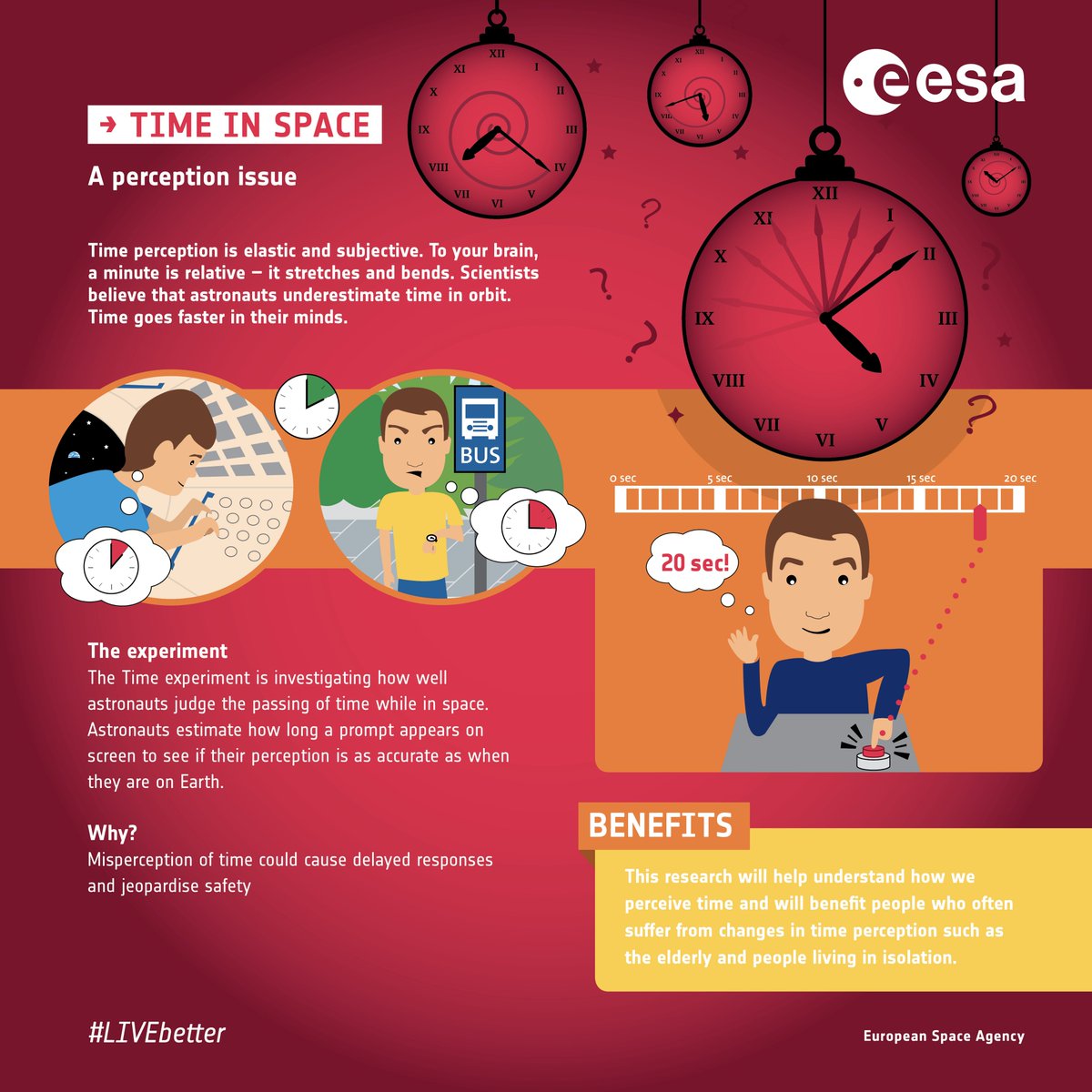
Dreams
The Dreams experiment sees Thomas’ sleep put under the magnifying glass. The experiment uses a novel sleep headband to study how sleep is influenced by living in weightlessness and isolation. Using small ECG sensors, this biomedical device will collect neuroscientific data that will help prepare for long missions to the Moon and Mars.
Educational and cultural activities
Thomas ran a number of educational activities, recording videos for Story time from space, ESA’s kids mascot Paxi and the train-like-an-astronaut MissionX campaign. He setup the educational computers AstroPi to run student code for this year’s competition too.
Earth and space science
Radiation – LIDAL
Thomas returned the radiation monitor LIDAL to its original position after running the GRIP experiments. LIDAL is an addition to the existing ALTEA facility, upgrading ALTEA’s ability to take measurements that can be converted by dedicated software in real-time to become a dosimetric risk meter aboard the ISS.
Alpha Magnetic Spectrometer
It’s a small task but it still counts. A laptop that is linked to AMS-02, an external facility searching for dark matter is rebooted at regular intervals, just like you should reboot your computer at home every now and again. Thomas had the honours of doing this task in his 100 days of space.
Spacecraft movement
To do all this science, cargo spacecraft need to bring supplies, and crew spacecraft bring the humans. First of there was the launch. On 23 April 2021, 09:49:02 GMT, now 100 days ago, Thomas blasted off Earth as part of Crew-2 together with NASA astronauts Shane Kimbrough and Megan McArthur and JAXA astronaut Aki Hoshide, docking with the Space Station 24 April at 09:08 GMT at the forward-most port.
Just over three months into his Alpha mission, Thomas has seen seven spacecraft come and go, the 20-year old Pirs module leaving for good and the arrival of Nauka with a very special passenger, the European Robotic Arm.
- Roscosmos Soyuz MS-18 with Mark vande Hei, Oleg Novitsky and Pyotr Dubrov arrived 9 April 2021 07:42 GMT and is still docked with the Station.
- SpaceX Crew Dragon Resilience with Crew-1 left on 2 May 2021 06:56:33 GMT
- Progress MS-17 78P arrived on 1 July 2021 at 00:59 GMT
- Cygnus NG-15 left on 29 June at 16:31 GMT
- SpaceX Cargo Dragon CRS-22 left on 8 July 14:40 GMT
- On 21 July 2021 the Crew-2 moved their Endeavour spacecraft to another port on the Node-2 module to free up the forward-facing port for the soon to arrive Boeing Starliner, a new commercial spacecraft.
- Progress MS-16 77P left on 26 July 2021, 10:55 GMT together with the Pirs module.
- Nauka docked on 29 July at 13:29 GMT
Each cargo mission brings fresh supplies, new equipment and science, requires unloading and loading with trash or items to return to Earth, a logistics exercise that takes quite some time.
Spacewalks
Thomas did no less than three spacewalks in the space of three weeks in June, together with Shane, to install new solar arrays on the International Space Station – more than 20 hours in outer space.
Episode 1
On the first spacewalk on 16 June, Shane and Thomas collected the solar arrays, released them from their carrier and moved them to the installation site on the port side of the Station.
A small technical problem in Shane’s spacesuit required him to return to the airlock and restart his Display and Control Module. This module provides astronauts with continuous information on pressure, temperature and other vital data during a spacewalk. Though the restart was successful and Shane was in no danger, the extra steps delayed the duo’s work, preventing them from completing installation of the first new solar array as planned. The spacewalk ended after 7 hours and 15 minutes.
Mission planners quickly adjusted the planning for the Space Station and on 20 June Shane and Thomas were helped into their spacesuits again for their fourth spacewalk together. This time it was to complete installation of the first new solar array and get ahead on the second.
Episode 2
During this second spacewalk the duo unfolded the solar arrays that are rolled into tubes for transport, aligned them, connected data cables and secured them to the mounting bracket. As an extra safety precaution, they connected the power lines during orbital night to avoid any chance of electric shock.
As Thomas and Shane waited for the night to arrive, Shane’s helmet lights and camera partially detached from his helmet but Thomas used some wire to successfully reattach them as a temporary fix.
From there the spacewalk went smoothly. Shane and Thomas connected the new solar array, watched it unfurl and prepared for the installation of the second new solar array. The second spacewalk lasted 6 hours and 28 minutes, with the duo arriving back at the airlock at 20:10 CEST (19:10 BST).
Episode 3
A third and final spacewalk for the duo happened on June 25 to finish installing the second pair of new solar arrays. This spacewalk proceeded without problems, and the two new solar arrays are already working and supplying power to the Space Station.
The design of the new solar arrays will be used to power the lunar Gateway that will be built in an orbit around the Moon – the next outpost in space for the agencies that run the International Space Station.
Thomas has now spent exactly 33 hours on spacewalks, all with Shane over the course of two spaceflights.
Maintenance
All of the above spacewalks, spacecraft and science is excluding the mandatory 2 hours of exercise every day, Saturdays spent cleaning the Space Station, and maintenance tasks. Some of the highlights for Thomas’ maintenance were the installation of a new toilet system that is lighter and recycles more waste. Moving an air duct to improve air flow between modules. Inspecting hatches after spacecraft dockings, emergency training, opening and storing items in the BEAM module, fixing the CEVIS exercise bicycle, six-month maintenance on the T2 treadmill and a check of the Carbo Dioxide Removal Assembly.
100 days of ground support
Most of these experiments are closely followed from the ground by the User Support and Operations Centres across Europe. Teams behind the scenes assist the astronauts in real-time in case of anomalies and monitor the progress of the experiments.
Together, they work for Thomas’ mission success.
The magic and the routine
“I am finding it magical every day, but there is also a lot of routine,” says ESA astronaut Thomas Pesquet reflecting on his first 100 days aboard the International Space Station during his second mission. As this his second mission, and the first one, Proxima, lasted 196, Thomas has spent 296 days in space as of 1 August 2021. Let’s have an in-depth look at the 100 days of Mission Alpha so far, an incredibly action-packed stay in space!
Science
The new spacecraft arrivals and spacewalks take up a lot of an astronaut’s time and are more visual, but Thomas fit in much science in his 100 days on Mission Alpha. The list below is organised by theme, but not even exhaustive, some of the smaller experiments are not mentioned.
Biology and biotechnology
The Grip and Grasp experiments
The Grip and Grasp experiments
Thomas’ first large-scale European experiment in space was a familiar one: he set up the Grip and Grasp equipment during his Proxima mission in 2017. Four years on he is running the experiments himself by wearing a virtual reality headset and grasping objects while motion trackers record his arm movement and speed.
Grip and Grasp are two neuroscience experiments looking into how our brain takes microgravity into account when grabbing or manipulating an object.
Results could shed light on how to treat patients showing a loss of vestibular function on Earth, and contribute to the design of touch-based interfaces in future deep space exploration. This research could also identify potential hazards for astronauts when they move between environments with different levels of gravity, such as landing on Mars.
Muscle tone with Myotones
Astronauts experience muscle weakening in space and when they return to living with the effects of Earth’s gravity after a mission. The Myotones experiment monitors the muscle tone, stiffness and elasticity of the astronauts’ muscles with a non-invasive, portable device on the Space Station.
Thomas completed the first two science sessions together with NASA astronaut Megan MacArthur. A total of 12 astronauts will be taking part in it in the hope of identifying the best countermeasures and improving the lives of many people affected by strained muscles. The device is already used on Earth as an alternative to muscle biopsies.
Plant water management
Thomas worked on NASA’s Plant Water Management system to grow plants in space, and was part of NASA’s Advanced Plant Experiment-07 (APEX-07) examining how changes in gravity and other environmental factors associated with spaceflight affect plants at the level of gene expression.
Worms in space
The Molecular Muscle-2 experiment is trying to understand why astronauts lose some of their muscle mass in space.
During spaceflight an astronaut’s body changes. Losing muscle mass can affect their ability to work on a long space mission. Astronauts can lose up to 40% of their muscle after 6 months in space.
The very small worms, which can only be clearly seen under a microscope are C. elegans. It seems incredible but in many ways the tiny worms are similar to humans and share some of the essential biological characteristics. The worms help show the effect of changes in space, including alterations to muscle and the ability to use energy.
Understanding the causes of muscle loss in space may help astronauts in the future and address health problems on earth. Muscle loss caused by ageing might be better understood and the research could improve treatments for conditions such as diabetes.

The Pirs docking compartment left the Space Station after 20 years of service and burned up safely in the atmosphere above the Pacific Ocean. Credits: ESA/NASA–T. Pesquet
Routine comes down to science – repetition is part of any research, and space is no exception. More than halfway through the mission, Thomas has supported numerous European and international experiments in microgravity.
Since Thomas is quite busy, we asked the scientists supporting the mission on the ground to help us pick up a few experiments from the over 200 investigations that are on his schedule, with 40 European ones. This is what they chose.
Oral Biofilms
This human research study observes how bacteria is affected by microgravity and investigates ways to counteract any potential harmful changes.
Technology development and demonstration
Pilote
Thomas and Megan are running sessions of the Pilote experiment in the European Columbus laboratory proposed by France’s space agency CNES. They have to virtually guide a drone through an obstacle course and grapple a spacecraft with a robotic arm.
The Pilote experiment evaluates a new way of providing tactile and visual feedback to astronauts when operating robots. A virtual reality headset and a haptic joystick recreate the feeling of pressure and touch when the astronauts fly a robotic arm.
The results from Pilote will help improve the astronauts’ robotic skills not only on the Space Station, but also for operating rovers on the surface of the Moon and Mars.
Ultrasonic tweezers
Thomas conducted an experiment last week looking at manipulating objects using acoustics. The Ultrasonic Tweezers experiment aims to test the principle of moving objects without any physical interaction.
An acoustic tweezer uses ultrasound to trap objects. By moving the sound beam it is possible to move an object with great precision. Thomas evaluated how the technique can be used in microgravity to capture small plastic or glass marbles and move them over an obstacle course.
Stable space bubbles with Foam Coarsening
Observing foams on Earth is tricky because the mixture of gas and liquid quickly starts to chang
Nanosats
Thomas worked together with Aki and Mark to prepare the launch of miniature cubesats from the Japanese Kibo module. Two satellites were launched, one led by the Univeristy of Manchester, and the other by Robertsville Middle School, the first will test aerodynamics in low Earth orbit, and the former monitor forest fires.
Everywear
Started during Thomas’ first mission Proxima, the Everywear app is an all-in-one solution for astronauts in space. Using their tablets and connected devices the app can store a wealth of information and present it to the astronaut. Thomas used the French demonstration to record his calorie intake.
3d Printer
The Space Station has a 3D printer to make parts as necessary. Thomas used it to print a part for the new toilet!
Lightweight Crew Communications Headset Deployement
Thomas setup a new radio communication device that as the name implies should be lighter and easier to work with.
Immersive Exercise
Astronauts exercise two hours a day to compensate for the loss of bone and muscle mass from living in weightlessness. The daily workout can quickly become repetitive in the closed and unchanging environment, leading to lack of motivation. The Immersive Exercise experiment aims to break the monotony with virtual reality. Coupled with the Space Station’s exercise bike, an astronaut can pedal in space while riding through Earth landscapes. Videos filmed in 360° on Earth are played back on the headset, with the speed changing depending on how fast the astronaut pedals. A number of scenes have been captured, including one trip around Paris and its monuments at Thomas’s request. Already in use in some terrestrial fitness centres, the Immersive Exercise equipment could evolve to include gradient difficulties to recreate mountain roads. The Immersive Exercise technology should keep astronauts motivated on the International Space Station and improve their performance – an important aspect to consider on longer missions to the Moon and Mars.
Physical science
Stable space bubbles with Foam Coarsening
Gravity pulls the liquid between the bubbles downwards, the small bubbles shrink while the larger ones tend to grow and the foam starts to collapse back to a liquid state.
But in space foams are more stable because the liquid does not drain in weightlessness. The Foam-Coarsening experiment began last year to study foams in depth for better applications on Earth, such as improving food production, light-weight structures for aircraft or radiology equipment in hospitals.
The cell cartridges contain a mixture of soap and water, where bubbles are generated by moving a piston at high speed. The foam is observed for up to 100 hours, during which the foam bubbles become larger but less in number. The results are analysed with laser optics and high-resolution cameras. Other applications for the experiment lie in healthcare. Acoustic tweezers could be used to remove kidney stones or deliver targeted medicine.
SUBSA
Similar in goal to ESA’s Electromagnetic Levitator research, NASA’s SUBSA experiment is trying to understand the metal casting process in space to make better alloys on Earth. By observing how metals solidify in space researchers hope to fine tune the industrial process for stronger, lighter metals with Solidification Using a Baffle in Sealed Ampoules (SUBSA).
Protein Growth
Thomas worked on NASA’s Protein Crystal Growth-2 experiment. Crystals grown in space are typically larger and clearer than ones grown on Earth. When the crystals are clearer, researchers can tailor-make medicines to fit specific areas on the protein, so researchers are experimenting in space to grow the protein structures needed on Earth.
Fluidics
The Fluidics experiment looks at a phenomenon called ‘sloshing’ – how liquids move inside closed spaces. The goal is to help industry design better satellite fuel-systems to increase their life and make them less expensive.
A second part of the experiment looks at surface turbulence in liquids. On Earth, gravity and surface tension influence how a force dissipates in waves or ripples. By conducting Fluidics in space, scientists could observe how surface forces behave without gravity – removing one factor from the equation simplifies understanding the phenomenon.
The experiment consisted of three small transparent spheres with a centrifuge to move the liquids inside. One sphere used for the wave turbulence experiment held distilled coloured-water, the other two spheres used for the sloshing experiments used a special liquid developed with low viscosity and little surface tension.
Aside from gaining a better understanding of the movement of fluids this experiment could help us understand our oceans and on a larger scale our planet’s climate as a whole.
In-Space4
Thomas worked on NASA’s “Investigating the Structure of Paramagnetic Aggregates from Colloidal Emulsions-4” experiment looking at liquids of colloids and how nanoparticles floating inside could be manipulated by magnets to make new structures – and new super materials with better qualities.
Human research
Generic health, sample taking, urine, blood and more
Regularly astronauts take samples for researchers and flight surgeons on Earth. Not the best part of the job, and Thomas didn’t escape this task either. Often done in the morning before breakfast the samples are stored in the Station’s freezers.
Thomas, like the other astronauts also took ultrasounds of his eyes, scanned his veins for thrombosis and assessed his hearing as well as running a tonometry session to measure intraocular eye pressure. Regular check-ups in space.
TIME
This experiment uses virtual reality to chart whether our perception of time changes when living on the International Space Station.
Since perceptions of time and space are believed to share the same neural processes, and research on depth perception in weightlessness has shown that astronauts often underestimate distance, scientists speculate that, for astronauts, time also flies in space.
The Time experiment on the International Space Station investigates the claim that time subjectively speeds up in microgravity.

Dreams
The Dreams experiment sees Thomas’ sleep put under the magnifying glass. The experiment uses a novel sleep headband to study how sleep is influenced by living in weightlessness and isolation. Using small ECG sensors, this biomedical device will collect neuroscientific data that will help prepare for long missions to the Moon and Mars.
Educational and cultural activities
Thomas ran a number of educational activities, recording videos for Story time from space, ESA’s kids mascot Paxi and the train-like-an-astronaut MissionX campaign. He setup the educational computers AstroPi to run student code for this year’s competition too.
Earth and space science
Radiation – LIDAL
Thomas returned the radiation monitor LIDAL to its original position after running the GRIP experiments. LIDAL is an addition to the existing ALTEA facility, upgrading ALTEA’s ability to take measurements that can be converted by dedicated software in real-time to become a dosimetric risk meter aboard the ISS.
Alpha Magnetic Spectrometer
It’s a small task but it still counts. A laptop that is linked to AMS-02, an external facility searching for dark matter is rebooted at regular intervals, just like you should reboot your computer at home every now and again. Thomas had the honours of doing this task in his 100 days of space.
Spacecraft movement
To do all this science, cargo spacecraft need to bring supplies, and crew spacecraft bring the humans. First of there was the launch. On 23 April 2021, 09:49:02 GMT, now 100 days ago, Thomas blasted off Earth as part of Crew-2 together with NASA astronauts Shane Kimbrough and Megan McArthur and JAXA astronaut Aki Hoshide, docking with the Space Station 24 April at 09:08 GMT at the forward-most port.
Just over three months into his Alpha mission, Thomas has seen seven spacecraft come and go, the 20-year old Pirs module leaving for good and the arrival of Nauka with a very special passenger, the European Robotic Arm.
- Roscosmos Soyuz MS-18 with Mark vande Hei, Oleg Novitsky and Pyotr Dubrov arrived 9 April 2021 07:42 GMT and is still docked with the Station.
- SpaceX Crew Dragon Resilience with Crew-1 left on 2 May 2021 06:56:33 GMT
- Progress MS-17 78P arrived on 1 July 2021 at 00:59 GMT
- Cygnus NG-15 left on 29 June at 16:31 GMT
- SpaceX Cargo Dragon CRS-22 left on 8 July 14:40 GMT
- On 21 July 2021 the Crew-2 moved their Endeavour spacecraft to another port on the Node-2 module to free up the forward-facing port for the soon to arrive Boeing Starliner, a new commercial spacecraft.
- Progress MS-16 77P left on 26 July 2021, 10:55 GMT together with the Pirs module.
- Nauka docked on 29 July at 13:29 GMT
Each cargo mission brings fresh supplies, new equipment and science, requires unloading and loading with trash or items to return to Earth, a logistics exercise that takes quite some time.
Spacewalks
Thomas did no less than three spacewalks in the space of three weeks in June, together with Shane, to install new solar arrays on the International Space Station – more than 20 hours in outer space.
Episode 1
On the first spacewalk on 16 June, Shane and Thomas collected the solar arrays, released them from their carrier and moved them to the installation site on the port side of the Station.
A small technical problem in Shane’s spacesuit required him to return to the airlock and restart his Display and Control Module. This module provides astronauts with continuous information on pressure, temperature and other vital data during a spacewalk. Though the restart was successful and Shane was in no danger, the extra steps delayed the duo’s work, preventing them from completing installation of the first new solar array as planned. The spacewalk ended after 7 hours and 15 minutes.
Mission planners quickly adjusted the planning for the Space Station and on 20 June Shane and Thomas were helped into their spacesuits again for their fourth spacewalk together. This time it was to complete installation of the first new solar array and get ahead on the second.
Episode 2
During this second spacewalk the duo unfolded the solar arrays that are rolled into tubes for transport, aligned them, connected data cables and secured them to the mounting bracket. As an extra safety precaution, they connected the power lines during orbital night to avoid any chance of electric shock.
As Thomas and Shane waited for the night to arrive, Shane’s helmet lights and camera partially detached from his helmet but Thomas used some wire to successfully reattach them as a temporary fix.
From there the spacewalk went smoothly. Shane and Thomas connected the new solar array, watched it unfurl and prepared for the installation of the second new solar array. The second spacewalk lasted 6 hours and 28 minutes, with the duo arriving back at the airlock at 20:10 CEST (19:10 BST).
Episode 3
A third and final spacewalk for the duo happened on June 25 to finish installing the second pair of new solar arrays. This spacewalk proceeded without problems, and the two new solar arrays are already working and supplying power to the Space Station.
The design of the new solar arrays will be used to power the lunar Gateway that will be built in an orbit around the Moon – the next outpost in space for the agencies that run the International Space Station.
Thomas has now spent exactly 33 hours on spacewalks, all with Shane over the course of two spaceflights.
Maintenance
All of the above spacewalks, spacecraft and science is excluding the mandatory 2 hours of exercise every day, Saturdays spent cleaning the Space Station, and maintenance tasks. Some of the highlights for Thomas’ maintenance were the installation of a new toilet system that is lighter and recycles more waste. Moving an air duct to improve air flow between modules. Inspecting hatches after spacecraft dockings, emergency training, opening and storing items in the BEAM module, fixing the CEVIS exercise bicycle, six-month maintenance on the T2 treadmill and a check of the Carbo Dioxide Removal Assembly.
100 days of ground support
Most of these experiments are closely followed from the ground by the User Support and Operations Centres across Europe. Teams behind the scenes assist the astronauts in real-time in case of anomalies and monitor the progress of the experiments.
Together, they work for Thomas’ mission success.




